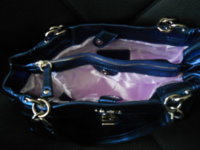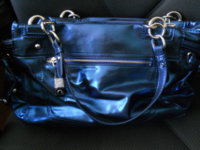We've had a few questions come up lately about Coach creeds and early plants so here's what I've been able to put together so far. It's still very incomplete so if anyone has more accurate information to add it's always welcome. Bonnie Cashin styles for the most part didn't have creeds so aren't covered here.
Here's an interesting article from the early 2000s that goes into Coach's early production and sales history:
http://www.fundinguniverse.com/company-histories/Coach-Inc-Company-History.html
Early Coach bags - 1970s-era - would usually just have a small "Coach" plaque clamped into the leather or lining. Coach began adding full creed statements sometime in the mid-1970s, with or without serial numbers. All the early Coach bags were made in Coach's New York City plant at 516 West 34th Street and the creed stamps had "Made in New York City U.S.A." at the bottom.
As near as we can tell, Coach started using the "Made In the United States" statement at the bottom of the creed when they added a second US plant some time in the mid to late 1980s. Before that the creeds just used the Made in New York City stamp. A second plant was opened in Miami in 1988 according to the article I posted in the above link so that would be my guess as to when the new Made in the United States creed was created. And of course the early pebbled leather bags like the Italian-, US- and Costa Rican-made Sheridans, Dakotas and Madisons from about 1991 thru the mid-90s had their own unique creeds (often without any serial numbers). Coach also had a plant in Puerto Rico sometime around 1993 but apparently that plant also was considered a U.S.plant since Puerto Rico was never mentioned on any creed. The NYC "A" plant was closed sometime before 1994 and the factory building became Coach's corporate offices.
Early serial numbers from before 1994 were a 7-digit string of numbers only, and each was unique to each bag. Early numbers were in a 3+4 number format up until around 1989 or 1990 when they were changed to a 4+3 arrangement. Because numbers were hand-stamped, sometimes mistakes would be made and instead of a dash between the two halves of the serial number, an extra number might appear instead. The early serial numbers were random and there's NO way to tell an item's style from those serial numbers.
Then beginning in 1994 the entire creed style and format were changed and the country of origin was stated in the body of the creed along with the plant code being added to the new style serial number along with the month and year codes. So bags that have the creeds saying "...It was made in (country)..." should have the 1994-version serial number that begins "Letter Number Letter-4 numbers" (unless they're Sheridans, Dakotas or some Madisons without serial numbers). If a serial number includes a letter of the alphabet as its first digit, it was made in 1994 or later and should include Coach's month, year and plant codes in the first half of the number and the item's style number in the second half. There should ALWAYS be at least 3 digits in the first half of the number.
Coach was also expanding its factory base outside the US and in the 1990s and early 2000s added handbag plants in Puerto Rico, Italy, Dominican Republic, Costa Rica, Hungary, Turkey, Mexico, China and possibly Thailand. Coach's small accessories were made in even more countries including Spain. (Recently Coach has also begun making bags in Vietnam and India).
Along with expanding their plants, the serial numbers and creeds have expanded as well. Formats, designs, the number of digits in the serial numbers and the wording and styles of the creeds themselves change
constantly so extreme care has to be used when trying to authenticate a bag based on the creed - leave creed analysis to the experts.
(Some of this information is from second-hand sources but I'm assuming it's fairly accurate until a more reliable source comes along. The rest of it has just been pieced together over the years by a few Coach junkies studying thousands of different bags. Coach themselves hardly ever make this kind of information public).




